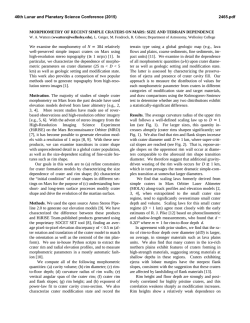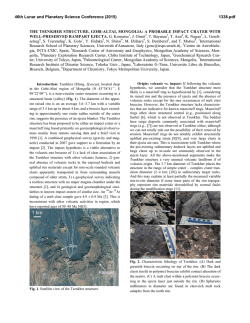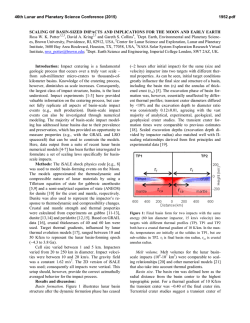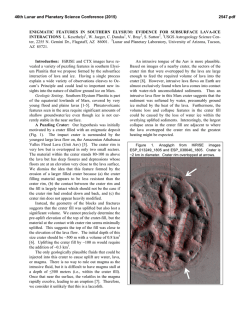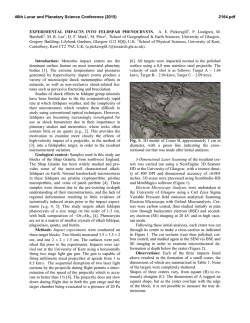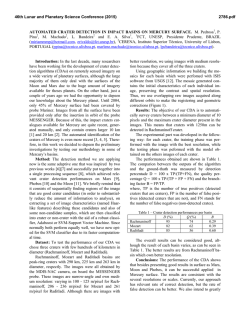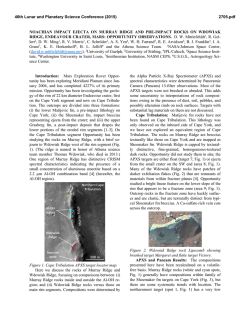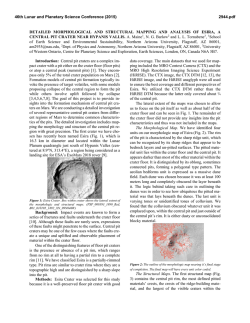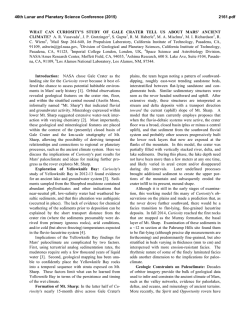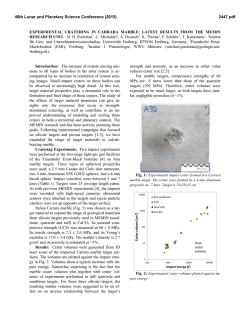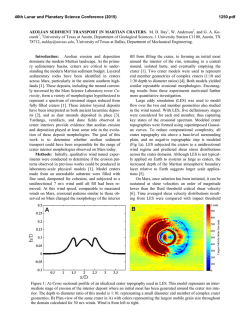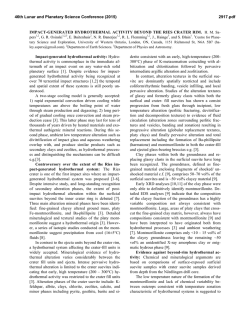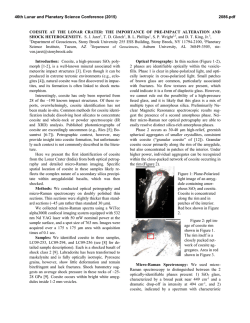
Opportunity In Situ Geologic Context of Aqueous - USRA
46th Lunar and Planetary Science Conference (2015) 2209.pdf OPPORTUNITY IN SITU GEOLOGIC CONTEXT OF AQUEOUS ALTERATION ALONG OFFSETS IN THE RIM OF ENDEAVOUR CRATER. L. S. Crumpler1, R. E. Arvidson2, W. H. Farrand3, M. P. Golombek4, J. A. Grant5, D. W. Ming6, D. W. Mittlefehldt6, T. J. Parker4, 1New Mexico Museum of Natural History & Science, 1801 Mountain Rd NW Albuquerque, NM, 87104, USA, [email protected], 2Washington University in St Louis, St. Louis, MO, USA, 3Space Science Institute, Boulder, CO, USA, 4Jet Propulsion Laboratory, Caltech, 4800 Oak Grove Drive, Pasadena, CA 91109, 5Smithsonian Institution, NASM CEPS, 6th at Independence SW, Washington, DC, 20560, 6NASA Johnson Space Center, Houston, TX, United States, 77058, USA Introduction: Mars Exploration Rover Opportunity traversed 7.9 km and 27 degrees of arc along the rim of the 22 km-diameter Noachian "Endeavour" impact crater since its arrival 1200 sols ago. Areas of aqueous and low-grade thermal alteration, and changes in structure, attitude, and macroscopic texture of outcrops are notable across several discontinuities between segments of the crater rim. The discontinuities and other post-impact joints and fractures coincide with sites of apparent deep fluid circulation processes responsible for thermal and chemical alteration of local outcrops. In Situ Geology of Rim: Opportunity determined the elemental, spectral, and petrographic character of distinctive outcrop lithologies along the crater rim [cf. 1, 2, 3, 4]. The petrologic results, contacts, attitudes of bedding, and structures have been mapped along a swath determined by the limit of Navcam detection, empirically defined at ~20 m distance from the rover [4]. Outcrops examined along the rim crest and upper slopes at Cape York and south at Murray Ridge consist of impact breccias ("Shoemaker formation") from >> 5 m thick overlying smectite bearing [1] fine-grained pre-impact materials ("Matijevic formation") (>>3 m thick), both laced with thin (1-2 mm) CaSO4 veins [1]. An overlying unit ("Grasberg formation") (<1m thick) drapes in unconformable contact over the deeply eroded Shoemaker breccias. The eroded and weathered upper surface of the moderately dipping (~10°) Grasberg fm is in turn overlain by the sulfate-rich sands of the "Burns formation" (>100m thick) constituting most of the surface of Meridiani Planum and partially burying and filling Endeavour crater. Mapping has continued south of Cape York along the western margin of Endeavour crater (Fig. 1). A consistent stratigraphy determined from correlation of results from site to site, along with determination of attitude of contacts [4], outlines the geologic history and sequence of alteration events. The recognition of an azimuthally segmented structural fabric of the rim correlates with distinct sites of identified petrologic differences and intensities of aqueous alteration. Segmented Structural Regimes: Segmentation of the crater rim occurs as azimuthal discontinuities in relief Figure 1. A. In situ mapping along Opportunity's traverse. Dashed lines denote boundaries between left and rightstepping rim segments, across which structure, outcrop characteristics, and elemental abundances differ. B-F. Sites of in situ measurements discussed in the text (white dots). 46th Lunar and Planetary Science Conference (2015) and patterns of surface roughness. In situ detection of differences in geologic character and disparities in structural grain across these segments are apparent along the rim from Murray Ridge and southward to Cape Tribulation. Alteration is pervasive at outcrops throughout the rim, but it is at or near the boundaries between segments where the most intense alteration [5] has been observed. General Rim Structure: The crater rim consists of right and left-stepping segments and low and narrow segments that are sinuous. The western slopes are planed along uniform grades of ~10° while bedding/laminations of outcrops exceed the slope angle (~10°). But planar features east of the rim consistently dip shallowly eastward, as do outcrops observed along-strike in the vicinity of segment offsets. The origin of a uniform sloping pediment-like planation of the western slopes across the dipping beds remains unclear. Solander Point (Fig 1b): The geologic sequence here is consistent with that noted 1500 m to the north at Cape York in which the Burns fm is in unconformable contact with the dipping weathered carapace of the Grasberg fm. Structural contours on the contact between the BurnsGrasberg fms and the Noachian rim breccias ascends from east to west around Solander Point implying a thinning of the late sulfate sands inboard of the crater rim. Laminations or layering of the Shoemaker fm breccias dip westward (~20°) along a ridgeline ("Murray Ridge") that continues south 800 m. Cook Haven (Fig 1c): Observations during the 5th winter were conducted at "Cook Haven", where Murray Ridge steps left and there is a change in relief, outcrop habit, and plunge of the ridge crest. Fractures in the plains to the west are coincident with the strike (N69W) of the discontinuity in ridge characteristics, denoting a possible relationship with a deep-seated fracture. Unusual exposures in the outcrop here have oxidized coatings enriched in Mn deposited on sulfates suggesting enhanced low-grade oxidizing, and possible thermal, aqueous deposition [5, 8]. "Al-OH Region" (Fig 1d): 400m south of Cook Haven Murray ridge steps left. This segment is notable in that CRISM spectra detected the presence of aluminous smectite [6]. Also, near the crest and on the western slope near the step "Pillinger Point", CaSO4 veins are more prominent in rim outcrops than elsewhere. Both observations indicate that in addition to acting as zones of enhanced alteration, the discontinuities are also boundaries on segments with different prevailing alteration histories. Wdowiak Ridge (Fig 1e): Dark, fine-grained rocks occur at two locations, 80 m south of Cook Haven and at Wdowiak Ridge, an unusual ridge aligned with the north margin of the right-stepping Cape Tribulation rim segment. The rocks capping Wdowiak Ridge are a dense 20 m x 200 m mass several meters thick of irregularly fractured dark blocks perched several meters above the sur- 2209.pdf roundings and represent yet another manifestation of segment boundaries. The dark rocks are compositionally distinct from the Shoemaker formation breccias of the crater rim [6]. Given the deep erosion of the crater rim [7] and similar rocks elsewhere along the crest of the crater rim, inversion of topography representing former trough aligned along the segment boundary appears likely. Either the dark rocks were emplaced as massive deposits (impact melt?) or fragmented, mobilized, and collected in the trough. "The Fracture" (Fig 1f): Outcrops are sparse on the tilted planar slopes of the ridge leading up to Cape Tribulation summit. Tangential and radial fractures occur here not seen elsewhere in Noachian outcrops along the rim. Opportunity examined outcrops exposed in a radially oriented example, a simple 2-3 m wide graben, "The Fracture". Higher Cl and S concentrations in these outcrops highlight the potential for any vertical discontinuity to enhance localized fluid flow. Interpretation: Discontinuities in the rim are consistent with development of transverse faults as the upward and radial compression of the upper crust during crater formation is accommodated by a series of discontinuous oblique thrust faults along discreet blocks. The relative motion between blocks would require accommodation by vertical dip, oblique slip scissor faults or lateral ramp structures. Inspection of MRO/HiRISE image data along the rim of Santa Fe crater, in Chryse Planitia (19.5°N 48.0°W), a similar size (21 km), but much younger (Amazonian) complex crater, suggests that the fault zones may re-activate as oblique slip zones accommodating inboard extension within crustal blocks during post-impact modification. Mylonization and fault-line brecciation along the bounding deep crustal faults serve as major vertical discontinuities and high permeability pathways along the rim. Both post-impact hydrothermal circulation [8] and regional groundwater much later would preferentially follow these zones during the processes associated with subsequent aqueous alteration. Conclusions: Rim segmentation by transverse faults enhanced aqueous chemical alteration in specific locations along the rim of Endeavour crater. Fracture controlled alteration may be another origin for hydrated minerals detected along the rims of many Noachian craters [9]. Combined with the apparent exposure of preimpact lithologies, as noted in the rim at Endeavour [4], impact crater rims also favor retention of physical and chemical evidence of past complex aqueous environments and chemistries. References Cited: [1] Squyres et al, (2012). Science 336, 570; [2] Arvidson et al., (2013). Science; [3] Ferrand et al., (2014), JGR, in press; [4] Crumpler et al., (2014), JGR, in revision; [5] Arvidson et al., (2015), this conference; [6] Mittlefehldt et al., (2015), this volume [7] Grant et al., (2015), this volume; [8] Newsom et al., (1986), JGR, 1981, [8] Ming et al, (2015), this conference; [9] Fairen et al, (2010). Proc.Nat'l A.S., 107. 12095-12100.
© Copyright 2025
